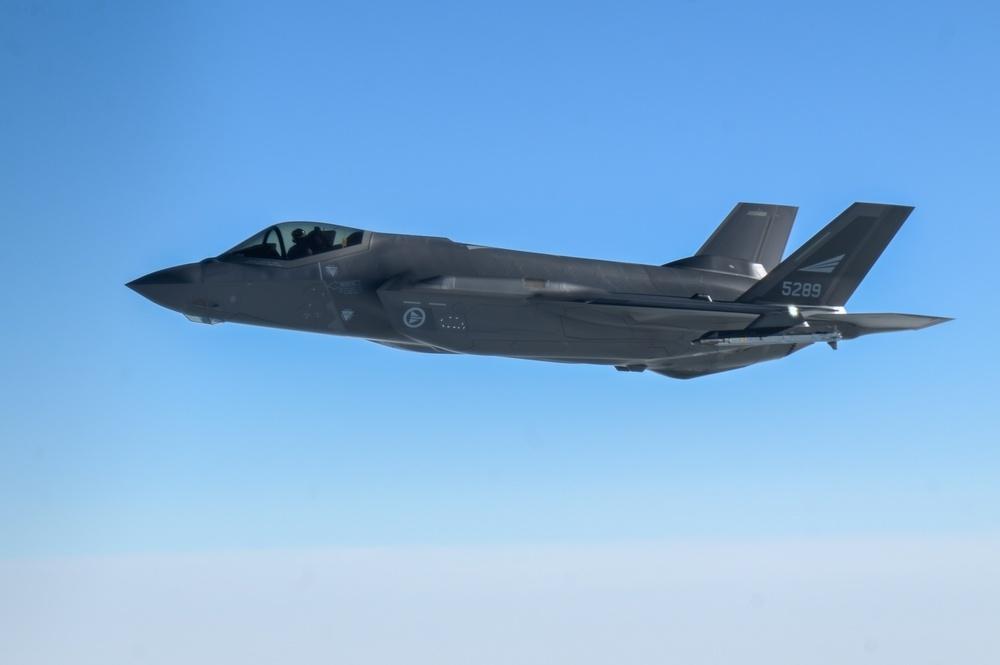Testimony from the USAF general leading the F-35 program indicates that software issues could halt production, delaying international F-35 deliveries. Lockheed agrees.
Lieutenant General Michael Schmidt, Program Executive Officer and director for the F-35 Lightning II Program, provided written testimony to the House Armed Services subcommittee last week in which he affirmed that developmental and concurrency-related delays to major F-35 upgrades could force Lockheed Martin
LMT
According to Schmidt, the development and concurrency issues relate to two major upgrades the F-35 is slated to receive.
A planned Block 4 software upgrade will broaden the menu of optional long-range precision weapons that the Joint Strike Fighter can carry, enhance its target identification prowess and most importantly, elevate its already powerful electronic warfare capability. But according to a recently released Government Accountability Office (GAO) report, the upgrade, which was supposed to be complete in Fiscal 2026, is now not expected to be completed until 2029.
A simultaneous Technology Refresh 3 (TR-3) is updating F-35 hardware and software, bringing with it improved cockpit displays, more computer memory and more processing power. TR-3 underpins Block 4 which rests upon its improved memory and processing infrastructure. It was originally slated to be ready in April 2023 but may be over a year late.
“Development and production concurrency is Block 4′s most critical challenge, and we are dealing with its consequences today,” Schmidt said in his testimony. “The F-35 [Joint Program Office], Lockheed Martin, and other industry partners have identified high risk concurrency in the F-35 Block 4 schedule, which would threaten to shut down aircraft production if development slips.”
Defense News reported that at last week’s in-person hearing, Lt.Gen. Schmidt observed that slow production of some major elements for TR-3 has delayed the final assembly of some new jets at Lockheed Martin’s production facility in Fort Worth, Texas.
But in an emailed response to questions, a Lockheed Martin spokesperson told me that the company is producing the 156 jets it planned to produce in 2023 – it just isn’t delivering them all.
As Defense News pointed out, the government is not currently accepting newly built F-35s intended to have TR-3 installed, partly because the upgrades are not complete and partly because it cannot carry out the necessary check flights. The lack of check flights is related to limited availability of dedicated test aircraft – F-35s configured to flight test the Block 4 and TR-3 modifications.
According to the GAO, the program had seven test fleet aircraft, with four devoted to TR-3 testing and three able to test Block 4 capabilities as of last Spring. Plans called for incorporating additional test aircraft for a total of 14 flight test aircraft for testing Block 4 capabilities.
According to Schmidt’s testimony last week, the program has the funding and other resources necessary to convert a further three production F-35s into the test jets. But he added that six more airplanes will be needed to perform all the required testing. Congressional authorization is required to make this happen.
Without the additional test assets and with slips in the delivery schedule for Block 4/TR-3 capabilities, Lockheed Martin’s aircraft delivery schedule appears to be impacted. While that has implications for the U.S. military, it remains logically at the head of the line. Lockheed’s latest foreign customers may not be.
Poland, Switzerland, the Czech Republic, Canada, Germany and Finland have bought F-35s scheduled for delivery between 2025 and the early 2030s. In 2022, Lockheed set a long-term objective to produce 156 F-35s a year. It delivered 141 airplanes in 2022 and will deliver 97 in 2023.
But if, as it says, Lockheed is on target to produce 156 airplanes this year, then there will potentially be 59 F-35s with partial Block 4 and TR-3 upgrades sitting idly on the flightline at Lockheed’s Fort Worth facility or elsewhere as of January 1, 2024, awaiting software and hardware before they can be turned over to customers.
In a 2023 delivery target and production rate statement (released Sept. 6, 2023) Lockheed Martin said, “We are producing F-35s at a rate of 156 per year and expect to continue at that pace while simultaneously working to finalize TR-3 software development and testing. Additionally, we remain focused on receiving the necessary hardware from our suppliers to deliver this critical combat capability for the F-35.”
The company forwarded the same statement to me yesterday afternoon. Lockheed added that it has updated its F-35 TR-3 schedule projections “with a first TR-3 aircraft delivery between April and June 2024.”
Given another annual 156-unit production run in 2024, that could mean that by June Lockheed will have assembled another 78 or so F-35s, bringing the total undelivered tranche of Lightning IIs to as many as 137.
The delivery delays will almost certainly affect Lockheed’s latest European customers and possibly others. That reality was already manifest last August when Belgium joined the U.S. in refusing to accept F-35s while it awaited completion of the TR-3 updates.
At a formal rollout ceremony for the first Belgian Air Component F-35 in Fort Worth last week Belgian prime minister, Alexander De Croo, stressed the importance of the stealth fighters his country will not likely see until next spring.
Important though they may be, Lockheed’s vice president of aeronautics, Greg Ulmer, told assembled local media that Lockheed does not foresee increasing its annual production rate to meet pressing delivery deadlines.
“We don’t want to necessarily produce above 156 for a very short time horizon,” Ulmer said. “That wouldn’t be efficient and wouldn’t be cost effective. So, we just have to be very careful with that approach.”
It’s an approach that analyst, Richard Aboulafia noted could become problematic in an article I wrote on the potential Czech sale in late 2022. Aboulafia said then that push could come to shove for the European F-35 delivery schedule.
“It really depends on how flexible other customers can be with their delivery schedule,” he opined. “But given the geopolitics and requirements behind all the orders, very few are going to be flexible, and Lockheed is unlikely to get much beyond 156 in 2027.”
How much of a delay particular customers may face is unknown, probably by Lockheed itself but the company did not argue the point that F-35s will not be delivered on time in some cases.
I specifically asked Lockheed F-35 program representatives what it is telling its international customers with fast-approaching delivery dates (Canada, Czech Republic, Switzerland, etc.) about their production allotments and delivery schedules.
In a separate emailed response, a Lockheed spokesperson relayed its statement that, “Impacts will be informed based on the remaining TR-3 test schedule, and customers impacted in 2024 are aware of the delivery delays.”
While Lockheed did not specifically say so, it’s reasonable to assume that customers with delivery dates in 2025 through 2030 and possibly beyond may need to be aware of delivery delays, TR-3 and Block 4 upgrade completion notwithstanding.
If you’re a future F-35 operator sitting in Helsinki, Bern or Berlin, you’ll likely have to plan for that.
Read the full article here





